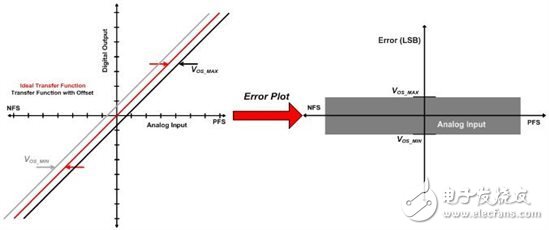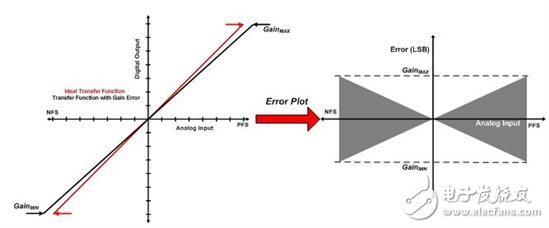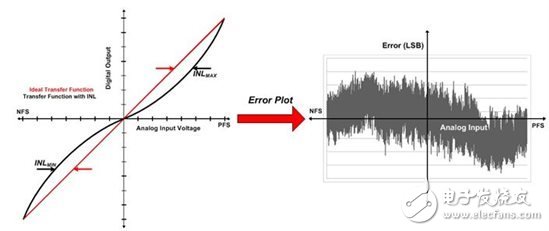We determined the difference between the resolution and accuracy of the analog-to-digital converter (ADC). Now we delve into the factors that have an impact on the total accuracy of the ADC, usually the total unadjusted error (TUE).
Have you ever thought of the "total" representation of the ADC's TUE specification? Is it simpler to add all DC error specifications (ie, offset voltage, gain error, INL) to the ADC data sheet, or is it more complicated? In fact, TUE is the ratio of the total system error to the ADC operating input range.
More precisely, TUE is a DC error specification in units of least significant bits (LSBs). The least significant bit (LSB) represents the maximum deviation between the ADC's actual and ideal transfer functions. This technical specification assumes that no system-level calibration has been performed. Conceptually, TUE is a combination of the following non-ideal types of values ​​in the ADC operating mode:
Offset Error (VOS): As shown in Figure 1, the constant difference between the actual and ideal transfer curves of the ADC. This value is the digital output obtained by shorting the ADC input to ground.

Figure 1. Relationship between ADC offset error and input voltage
Gain error: The difference between the actual and ideal slope of the ADC output. It is usually expressed as the ratio of ADC range or maximum error on the full-scale output code. As shown in Figure 2, the absolute value of the gain error increases when the analog input approaches full-scale value.

Figure 2. The relationship between ADC gain error and input voltage
Integral Nonlinearity (INL): The maximum nonlinear deviation of the actual ADC transfer curve to the ideal linear operation. The INL response of the ADC is not a certain shape and depends on the internal circuit architecture and the distortion caused by the front-end signal conditioning circuit.

Figure 3. Relationship between ADC INL error and input voltage
Most ADC data sheets specify the typical and maximum values ​​for all of the above DC errors but do not specify a value for TUE in this respect. Calculating the maximum value of TUE may not be as simple as adding together all the individual DC error maxima. This is because all of these errors are irrelevant, and in the worst case offset, the gain and linearity errors may not all appear at the same input voltage of the ADC transfer function. Therefore, the simple summation of errors may make the system's accuracy not necessarily so bad. This is especially true when the dynamic range of the application is limited to the middle of the transfer function.
In this typical data acquisition system, together with the ADC, there is also an input driver and a voltage reference. They also affect the overall offset and gain error. Therefore, in most systems with no calibration, the offset and gain errors determine the INL used when calculating the maximum TUE. The recommended method for calculating the maximum TUE on a particular analog input voltage is the root sum of all single-error maximums at that point (Equation 1). It is important to convert all these errors into the same unit, which is usually converted to LSB.

Equation 1 generates an error map of a typical "bow" shape for TUE. For systems with higher offset errors, the "bow" graph has a thicker junction (Figure 4A). Conversely, for systems with higher gain errors, the "bow" knot becomes thinner and the bow becomes thicker (Figure 4B).

Figure 4. Relationship between ADC TUE and input voltage for "bow" shape
In general, because the error depends on the input voltage range when the ADC is operating, the formula for determining the maximum TUE of the ADC is not calculated. If the system does not require the entire ADC input range, you can greatly reduce TUE by running the ADC away from the endpoints of its transfer function.
1U Network Server,1U Rackmount Industrial Pc,1U Network Appliance,1U Rackmount Server
Shenzhen Innovative Cloud Computer Co., Ltd. , https://www.xcypc.com